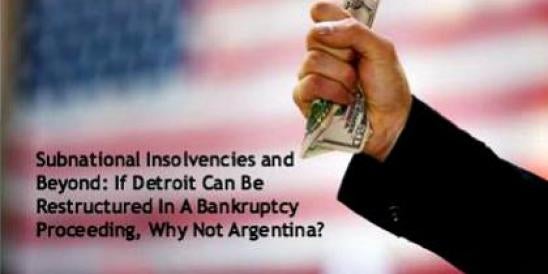“You cannot properly appraise the real seriousness of that situation unless you are right there in the city. Everything that frugal men and women put aside for years to save for old age, to get security for themselves – everything that they put aside to make the lot of their children a better one than their own, is now likely to be swept away. There is only one way that you can lighten the load of the municipality and that is to take its debt service off for the time being. Specifically, so that you will understand it, what is it in the city of Detroit? Our budget [this year is] $72,200,000; our tax delinquency is $28,000,000—36 percent…I want to express the opinion to you that in the city of Detroit, next year, there will not be enough income to even pay the fundamental services of government, to keep your schools going, your police and fire departments, your health and welfare departments, let alone to take care of the debt services of that city.”
Frank Murphy, former Mayor of Detroit, testifying before the Judiciary Committee of the United States House of Representatives in 1933, in support of proposed municipal bankruptcy legislation
As is evident from the quotation above concerning the financial distress being suffered by the city of Detroit in 1933, the history of municipal insolvencies, often referred to as “subnational insolvencies,” is a long one. In the United States, the first serious bout of subnational insolvencies was triggered by the Panic of 1837, when the market for state bond financing of infrastructure projects (especially railroads) collapsed suddenly. Throughout the 1800s, a significant number of municipalities defaulted on debt obligations, resulting in various remedies being fashioned by state governments and courts to repay defaulted debts. One of the most celebrated cases involved the city of Memphis, Tennessee in the 1870s, when the city was placed into receivership by the state legislature, which then disincorporated Memphis and transferred its territory and municipal functions to a newly-created entity named “Taxing District of Shelby County.” Tennessee’s governor then appointed special commissioners to operate this district and repay the city’s past-due debt. In other cases, creditors whose claims remained unpaid could seek payment directly from the defaulting municipality via a writ of mandamus issued by a court of competent jurisdiction, which writ would require the municipality to impose new taxes for payment to the creditor.
This legal landscape dramatically changed in 1933, when the United States Congress enacted the first federal municipal bankruptcy statute which was also the first such statute in the world. This bill, commonly known as the “Wilcox Act” after its House sponsor, permitted (but did not compel) municipalities to negotiate settlements or compositions with their creditors. In the event that a certain percentage of creditors approved a negotiated composition, that settlement could be imposed on dissenting creditors. This statute, however, was struck down three years later by the United States Supreme Court on the ground that its provisions “might materially restrict [a municipality’s] control over its fiscal affairs.” The next year, however, Congress enacted another municipal insolvency statute similar to the Wilcox Act, but which nevertheless was upheld by the Supreme Court in 1938. Since that date, the federal bankruptcy laws have contained provisions providing for municipal insolvencies although their provisions have been amended many times over the intervening years.
The present statute is commonly known as “Chapter 9” of the United States Bankruptcy Code, 11 U.S.C. § 901-946. In order to qualify for Chapter 9 relief, the entity seeking relief must be a “municipality” within the meaning of section 101(40) of the Bankruptcy Code, i.e., it must be a “political subdivision or public agency or instrumentality of a state.” This category is broader than that contained in the Wilcox Act, which was limited to political subdivisions, e.g., cities. In addition, the filing entity must satisfy the five requirements in section 109(c) of the Bankruptcy Code, which include (i) a mandate that the municipality be “insolvent” in a cash flow sense; and (ii) the hurdle that the municipality has attempted to negotiate with its creditors in good faith but has failed to reach agreement with a majority of impaired claims or is unable to negotiate with those creditors “because such negotiation is impracticable.” The endgame of a Chapter 9 case is confirmation by the bankruptcy court of a plan adjusting the municipality’s debts. In order to be confirmed, the court must determine that all seven requirements contained in section 943 of the Bankruptcy Code have been satisfied by the debtor and the plan, the most important of which is the requirement that the plan be “in the best interests of creditors and is feasible.” The number of Chapter 9 cases that were filed after World War II were negligible, but this number spiked during and after the World Financial Crisis of 2008. At present, not only is the city of Detroit the subject of such a case, but also many mid-sized cities, such as Stockton and San Bernardino, California, are presently being administered by bankruptcy courts under Chapter 9.
Other National Laws Providing for Subnational Insolvency Proceedings
As mentioned above, the United States was the first country to adopt national legislation providing for bankruptcy relief for “subnational” entities, e.g., municipalities. Since then, however, a relatively small but growing number of nations have enacted legislation to provide similar relief, either through judicial or administrative action (or a mixture of both). In the decade of the 1990s, a number of significant defaults on debt instruments issued by national and subnational governments, including Argentina, Mexico and Brazil, occurred, which stimulated some nations to enact legislation providing for the restructuring of subnational debt. In 1996, Hungary enacted its Municipal Debt Restructuring Law which, like Chapter 9, provides a court-supervised process for reorganization of insolvent municipalities that is directed by an independent receiver or trustee. Similar legislation based on the Hungarian model was thereafter adopted by Estonia, Latvia and Romania in the first half of the 2000s. In 1999, Colombia enacted its first bankruptcy law, which included relief for highly indebted subnational governments by permitting them to negotiate debt restructuring agreements with creditors. These restructurings are accomplished by administrative action led by the Superintendency of Corporations working in conjunction with other governmental agencies. Other countries that have adopted administrative methods for restructuring debt of subnational governments, e.g., cities, counties and provinces, include Brazil, France and Italy. While this worldwide legislation has not yet produced a surge of national laws for the restructuring of governmental units below the level of nation-states, the number of countries enacting these types of laws is steadily increasing.
National Insolvency Proceedings: A Wave of the Future?
One might ask: If large cities such as Detroit may restructure its debilitating indebtedness through bankruptcy court proceedings, why shouldn’t heavily indebted nation-states be permitted to seek similar relief from a judicial or arbitral tribunal? Not surprisingly, this issue is being hotly debated now by politicians and academics. The traditional retort by critics of this radical approach to restructuring is that nations can right their own ship by raising taxes and even by printing more of its currency. However, these remedies are either unavailable or of little practical use by nations in a monetary union such as Greece, Spain and Portugal.
Stimulated by Argentina’s default on payment of its bonds in 2001, the International Monetary Fund (IMF) proposed the adoption of a “Sovereign Debt Restructuring Mechanism.” Papers on this topic published by the IMF described in broad terms the objectives and possible design features of the “SDRM” [Sovereign Debt Restructuring Mechanism] so as to assist nations whose debt had become unsustainable. These papers discussed the possibilities of (i) imposing a stay of creditor action against the defaulting nation-state while negotiations for debt restructuring continued, (ii) creating creditors committees to participate in the restructuring process and (iii) establishing a “Sovereign Debt Dispute Resolution Forum” with rule-making authority regarding claims administration and dispute resolution procedures. Although the IMF shelved this proposal in 2003 due to political pressures, the debate that it engendered has continued to flare up from time to time, especially in the wake of the World Financial Crisis of 2008 and the Eurozone Crisis of 2010. A number of prominent academics, led chiefly by Professor Christoph Paulus of Humboldt Universität zu Berlin, have published papers and other commentaries advocating the adoption of an SDRM to restructure sovereign debt in a managed way which could ameliorate the consequences of defaults on sovereign debt instruments, such as the Argentinean bonds that are now being addressed by the Second Circuit Court of Appeals. According to Paulus and his co-author, an
international arbitral tribunal carries with it several advantages. First, and most importantly, it is based on a consensus among the key stakeholders which is of high importance in a situation of such intense tensions such as a sovereign default. The second advantage - - and closely related to the first one - - is that an arbitration panel is an institution which elevates the dispute between the creditors and the sovereign debtor to a neutral forum and provides thus for what might be called a “de-emotionalization” of each individual dispute. Furthermore, it provides a forum for bringing some cohesion and structure to what is nowadays in cases of a sovereign default usually a more or less potentially disorganized group of anxious stakeholders who initiate individual strategies (more often than not in different places all over the globe) to secure the most profitable outcome for themselves.
The proposal for adoption of an SDRM is not without its critics, however, and often rasps against raw political nerves. As one Argentine critic recently argued,
[the creation of a SDRM] would transmute into a new edition of the IMF’s proverbial “recipes” to “help nations” totally and irretrievably in debt to once again “access international financial markets” so that they can re-program, roll-over, refinance, kick forwards defaulted, impossible-to-pay short-term debt, by mutating them into long-term, hugely profitable, high interest yield juicy performing debts.
That would look really nice on mega-banker financial sheets, and would ensure that gigantic amounts continue to flow out of troubled Nation-State public coffers and into mega banker private pockets!
As if horrific debt crises caused by artificially created unsustainable debt burdens could ever be resolved by taking on/imposing ever higher, heavier, long-term debt. One can almost hear the sucking sound in the dark recesses of the global financial system . . .
Modern mass slavery couldn’t have been better thought out. . .!
Conclusion
The extreme stress produced by the World Financial Crisis has exposed the fragile nature of the debt structure of subnational and national governments. As most graphically illustrated by the city of Detroit’s Chapter 9 case, many of these governmental units no longer have the tax base nor the borrowing capacity to service their existing indebtedness. On the national level, many third-world nations and even developed nations like Argentina, Greece and Spain cannot pay their sovereign debts as they mature. A growing number of nations are addressing this dilemma by adopting legislation that provides mechanisms for restructuring subnational debt incurred by local governments, either through judicial or administrative means. With respect to sovereign debt, no similar multinational structure exists to perform the same debt restructuring function. Adoption of an SDNA similar to that proposed by the IMF or academics such as Professor Paulus has so far been subverted by political opposition. Whether such a device will be adopted in the future on a worldwide or regional basis may depend upon the degree of severity of the next world financial crisis.



 i
i


